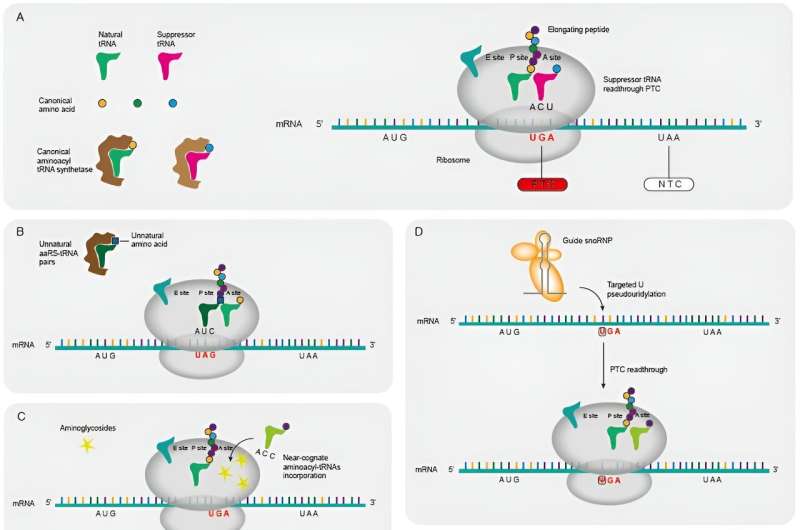This article has been reviewed according to Science X's editorial process and policies. Editors have highlighted the following attributes while ensuring the content's credibility:
fact-checked
peer-reviewed publication
trusted source
proofread
Review paper unveils the potential of suppressor tRNA in gene therapy

A review article provides a comprehensive overview of the biological mechanisms of suppressor tRNA, traces the development history of related research, explains the advantages and disadvantages of suppressor tRNA therapy compared to other readthrough therapies such as aminoglycoside drugs and PTC124, and analyzes the potential application of suppressor tRNA in gene therapy for diseases.
The paper is published in the journal Science China Life Sciences.
Genetic diseases caused by nonsense mutations account for about 11% of human genetic diseases. These mutations introduce stop codons (PTCs) (e.g., UAA, UAG, or UGA) into the genetic code, leading to premature termination of the translation process and the production of truncated, dysfunctional proteins.
Suppressor tRNA is a specially engineered or naturally occurring tRNA molecule. When a ribosome encounters a stop codon, suppressor tRNA introduces the corresponding amino acid into the growing polypeptide chain, allowing translation to continue and resulting in the production of full-length proteins.
Initially, tRNA was considered merely a transporter of amino acids. This view changed with the discovery of suppressor tRNA. In 1965, Engelhardt et al. experimentally demonstrated that suppressor tRNA could recognize stop codons and insert amino acids, bypassing the translation termination process. Subsequent studies further revealed the readthrough mechanism of suppressor tRNA in eukaryotes and showed its potential in gene therapy.
The first in vivo experimental study of suppressor tRNA was reported in 2000, successfully inducing readthrough in mice through local injection. With the advancement of genetic engineering technologies, the efficiency of synthesizing and modifying suppressor tRNA has continuously improved, broadening its application prospects in the treatment of genetic diseases.
Representative studies reported in 2022 and 2023 demonstrated the systemic delivery of suppressor tRNA using adeno-associated virus (AAV) and lipid nanoparticles (LNP) to treat diseases related to nonsense mutations.
Suppressor tRNA has unique advantages in clinical applications. It utilizes endogenous transcripts to treat genetic diseases, effectively avoiding potential cytotoxicity associated with the overexpression or off-target effects of exogenous proteins. Suppressor tRNA shows great promise in treating genetic diseases caused by nonsense mutations.
Several biotechnology companies, including Alltrna, ReCode Therapeutics, and Shape Therapeutics, are developing therapies based on suppressor tRNA. However, suppressor tRNA therapy still faces many challenges. The efficiency of PTC suppression depends on the surrounding sequence and the position of the PTC.
Engineered suppressor tRNA may reduce aminoacylation efficiency, and suppressor tRNA might also recognize normal stop codons, leading to the production of aberrant proteins. The use of non-natural amino acids could induce cytotoxicity, and high-dose delivery systems might trigger immune responses and cytotoxicity.
Although no tRNA therapy has yet been approved for clinical trials, the rapid development of molecular biology, bioinformatics, synthetic biology, and delivery systems is ushering suppressor tRNA gene therapy into a new era.
The article was written by the team of Yue Zhang from Liangzhu Laboratory and the team of Lei An from Henan University.
More information: Jingjing Ruan et al, Suppressor tRNA in gene therapy, Science China Life Sciences (2024). DOI: 10.1007/s11427-024-2613-y




















